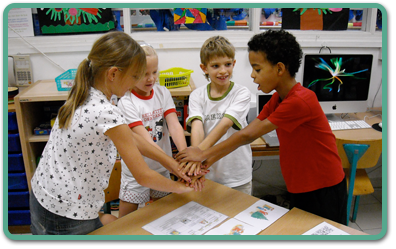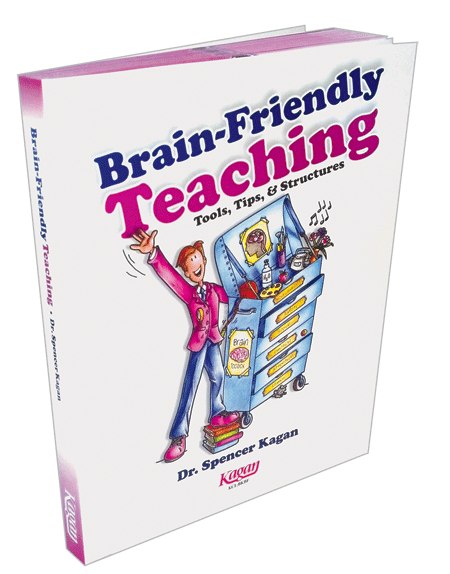Kagan's Articles - FREE Kagan Articles
Dr. Spencer Kagan
Spencer Kagan on Cheers, Celebration and Praise
Special Article
Spencer Kagan on Cheers, Celebration and Praise
Dr. Spencer Kagan
To cite this article: Kagan, S. Spencer Kagan on Cheers, Celebration and Praise. Kagan Online Magazine, Issue #55. San Clemente, CA: Kagan Publishing. www.KaganOnline.com


|
||||||||||
Good morning Spencer! The trainers are really enjoying the brain book study! It has generated a lot of great conversations. There is a question that has come up and although I have answered it based on my interpretation, I think it would be great to get your take on it. Several are asking for clarification between the difference between a specific praise, a celebration and a cheer. When we teach RallyCoach, we state that they need to give a "specific" praise. I interpret that as being more specific like... "you did a great job at adding those numbers in your head." Cheers I see more as celebrations although cheers could certainly be a form of praise. Can you clarify this for everyone? Maybe it would be good to address the difference between a specific praise, praise, celebration and cheer. I recognize that these definitely overlap but I think trainers would appreciate how you clarify the difference between them. Thanks so much!!! Jackie |
||||||||||

|
||||||||||
Thanks Jackie. Generic Praisers are something we can say that would apply to anything a partner did. Our canned praisers like the Cheese Grater praiser is one of many examples. Simply saying "good job" whether you mean it or not, is an example of generic praise — given insincerely. Not all generic praise is insincere: We can give a Hamburger Cheer with great enthusiasm and really mean to convey our appreciation of a performance. Generic praisers usually put a smile on the face of the partner, indicating they have delivered a dose of dopamine which hits the reward, motivation, and attention centers, as well as increasing memory for the performance (retrograde memory enhancement) and decreasing stress which increases cognitive performance. Class tone improves dramatically. Generic praisers, however, can be said whether on not we mean it or even whether or not we have paid attention to or processed what our partner has done. They can be inauthentic and do not focus the learner on the specific aspect of the performance that it would be good to reinforce. Specific Praisers are something we can say only to the specific performance that is being praised. They have all the positive impacts of generic praisers, but have the additional positive outcome of reinforcing a specific part of the performance and communicate to the partner that they are being attended to and received at a deep level. In addition, they hold the student offering the praise accountable for attending to the performance in some depth. If I am to give a generic praiser, I can tune out the performance and then given the generic praiser afterwards without really having appreciated the performance. Not so with a specific praiser — I must attend to the performance. Celebrations. Whereas praise is usually given in response to performance of an individual, cheers are usually given following a successful performance of a team or class. Praise is usually given by one person; celebrations are engaged in simultaneously by the whole team or class. Cheers. Cheers are a specific type of celebration. We all scored above 90 on the test and we give a Rollercoaster Cheer. A different way to celebrate would be 5 minutes of free time, or cake and ice cream. Cheers are but one way to celebrate. Timing. What the research on eliciting positive emotion (EPE) reveals is that praise and celebrations, including cheers, preceding performance enhance performance. Typically we have given cheers and praise following successful performances. The corrective offered by the study of EPE is that we are more likely to be successful if we give praise and cheers before the performance. Football and other sport teams have had it right — they do their huddle and cheer before the game. Cheers and praise following performance enhance memory for the performance, but it is too late to impact on the performance itself. Cheers and praise following performance have the potential to enhance future performance via enhanced memory of prior successful performance. Blurring. As a training company we have blurred the distinction between praise and cheers, and I think this may be a bit unfortunate. I have tried to correct this in the brain book. Saying "Great, Great, Great!" following a performance is praise. A Rollercoaster Cheer, might better be used as a cheer, rather than praise. Naturally, giving a Rollercoaster Cheer to an individual, intended as praise, is possible, so blurring the distinction is understandable. If I had my way, though, we would give praise to individuals before or after performance, and we would reserve cheers as something we do as a team or class. Praise is given by individuals; cheers are given by groups. I hope this helps, Spencer |
||||||||||

|
||||||||||
Spencer & Jackie, I'm so glad you sent this email because I was asked a question during my training today that related to this topic. I will process tonight the information you shared, but I'm still getting hung up on the wording of the question I received. During the Day 1 training we teach "Copy Cat Gambits" and this is what a teacher asked me: "If I have a student say a copycat gambit and they don't believe it to be true, then I feel like I'm encouraging them to lie." I tried to answer the question to the best of my ability but any further advice you may have would be greatly appreciated! Thanks, Stefanie |
||||||||||

|
||||||||||
Stefanie, It is a good question. I think we want to consider the context. When a person says a Copy Cat Gambit, they are just saying what the teacher tellls them to say; it is not necessarily their personal truth. For example, in workshops I sometimes have participants tell their partner, "You are simply, incredibly fascinating to listen to." Everyone says it and then has a laugh. No one takes it to be more than fun. We do, however, gain by having students practice praise and compliments, even if they are not heartfelt. Having given praise once, it is more likely they will give it again. Copy Cat Gambits disinhibit those who otherwise might not give praise, and this is a social skill. The teacher who is uncomfortable with Copy Cat Gambits does not have to use them. What we offer is options, not demands. Further, the teacher who is uncomfortable with Copy Cat Gambits, could perhaps become more comfortable by prefacing them with something like this: "In my class sometimes I will ask you to use a Copy Cat Gambit. I will ask you to say to a partner the exact words I give you to say. Please know, this is done for practice and fun, and the words do not have to reflect exactly how you are feeling. I might even ask you to tell a partner they are more intelligent that Einstein. We all know that isn't true, but it will be fun to say and fun to hear. Giving exaggerated praise puts a smile on the face of our partner, and actually changes brain chemistry in ways that help them learn. So let's have fun with Copy Cat Gambits. Tell your shoulder partner, 'I am really happy to be your partner.'" Spencer |
||||||||||
 Brain-Friendly Teaching
Brain-Friendly Teaching
Tools, Tips, & Structures
Dr. Spencer Kagan (All Grades)
Become a brain-friendly teacher! Put the power of brain research and theory to work in your classroom. Your students will learn more, learn more quickly, retain and recall more, and like learning more. Dr. Kagan's extensively-researched book distills the world of brain science into 6 essential principles that will align your teaching with how your students' brains naturally learn. For each of the 6 brain-based principles, you will find practical tools, tips, and structures to easily make the leap from theory to practice. Teaching is so much easier and more successful when you do it the brain-friendly way. 544 pages. Click here to learn more.